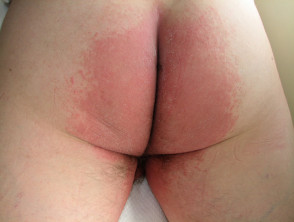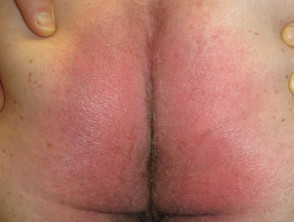What is symmetrical drug-related intertriginous and flexural exanthema?
Symmetrical drug-related intertriginous and flexural exanthema (SDRIFE) is an adverse drug eruption presenting as a distinctive erythematous rash involving the skin folds. It was initially called ‘baboon syndrome’ as the buttocks were predominantly affected in the first patients described with this reaction, although this may be an unrelated entity caused by sensitisation to a topical agent followed by systemic exposure.
Who gets symmetrical drug-related intertriginous and flexural exanthema?
Symmetrical drug-related intertriginous and flexural exanthema can affect all age groups, but is rare in children. SDRIFE shows a male predominance of 3:1.
What causes symmetrical drug-related intertriginous and flexural exanthema?
Symmetrical drug-related intertriginous and flexural exanthema is a type IV delayed hypersensitivity reaction to a systemic drug [see Allergies explained]. The reason for the characteristic distribution of the rash is not known.
Amoxicillin and other beta-lactam antibiotics (penicillins, cephalosporins) are the most common cause of SDRIFE, accounting for approximately 50% of cases. A detailed list of medications reported in association with SDRIFE is found in the appendix.
What are the clinical features of symmetrical drug-related intertriginous and flexural exanthema?
Symmetrical drug-related intertriginous and flexural exanthema appears hours to days after exposure to the medication. The rash presents as a well-defined redness of the buttocks, natal cleft, and/or upper inner thighs, resembling the red bottom of baboons. The redness is usually symmetrical and often forms a V-shape. The neck, axillae, and other large skin folds (flexures) may also be involved.
Rare clinical features include pustules, vesicles/bullae, petechiae/purpura, and oral mucosal lesions.
A key feature is the lack of systemic symptoms. The affected person is not unwell and the rash is not accompanied by any other symptoms.
Clinical presentation of SDRIFE
What are the complications of symmetrical drug-related intertriginous and flexural exanthema?
Symmetrical drug-related intertriginous and flexural exanthema has not been reported to be associated with any complications.
How is symmetrical drug-related intertriginous and flexural exanthema diagnosed?
Symmetrical drug-related intertriginous and flexural exanthema is usually a clinical diagnosis with the following suggested diagnostic criteria:
- Follows exposure to a systemic drug, either on the first occasion or after a repeated dose
- Sharply demarcated erythema of the buttocks and/or V-shaped erythema of the inguinal area
- Involvement of at least one other flexural site
- Symmetrical distribution
- Absence of systemic symptoms.
Skin biopsy shows nonspecific inflammation consisting of a superficial perivascular mononuclear cell infiltrate.
Patch tests applied to a previously affected area several weeks after recovery may show a positive reaction to the causative agent in 50% of cases. An oral challenge with the suspected drug (drug provocation test) will trigger the same skin reaction in the majority of cases.
What is the differential diagnosis for symmetrical drug-related intertriginous and flexural exanthema?
Differential diagnoses for symmetrical drug-related intertriginous and flexural exanthema can include:
- Contact dermatitis
- Acute generalised exanthematous pustulosis (AGEP)
- Drug hypersensitivity syndrome (DRESS)
- Flexural psoriasis.
What is the treatment for symmetrical drug-related intertriginous and flexural exanthema?
Treatment of symmetrical drug-related intertriginous and flexural exanthema requires the cessation of the suspected drug. Topical steroids may hasten resolution of the erythema.
What is the outcome for symmetrical drug-related intertriginous and flexural exanthema?
Symmetrical drug-related intertriginous and flexural exanthema is a benign self-limited reaction that resolves when the offending drug is withdrawn. However, it will usually recur on re-exposure to the causative drug.
Appendix: What drugs are reported to cause symmetrical drug-related intertriginous and flexural exanthema?
Alphabetical listing of agents reported to trigger SDRIFE (note this list may not be complete)
- 5-fluorouracil
- Allopurinol
- Aminoglycoside antibiotics
- Aminophylline
- Amoxicillin
- Aspirin
- Azithromycin
- Barium sulfate
- Beta-lactam antibiotics
- Bufexamac acid
- Celecoxib
- Cephalosporin antibiotics
- Cetuximab
- Cimetidine
- Clarithromycin
- Clindamycin
- Clozapine
- Codeine
- Corticosteroids
- Cotrimoxazole
- Doxycycline
- Erythromycin
- Ethinylestradiol/etonogestrel
- Ethyl loflazepate
- Etoricoxib
- Fluconazole
- Heparin
- Hydrochlorothiazide
- Hydroxyurea
- Hydroxyzine
- Infliximab
- Iomeprol
- Iopamidol
- Ioversol
- Itraconazole
- Mefenamic acid
- Metals (gold, mercury, nickel)
- Metronidazole
- Mitomycin C
- Mosapride
- Naproxen
- Nefopam
- Nystatin
- Omeprazole
- Oxycodone
- Paracetamol
- Penicillin antibiotics
- Pioglitazone
- Pristinamycin
- Pseudoephedrine
- Ranitidine
- Remdesivir
- Risperidone
- Rivastigmine
- Roxithromycin
- Secnidazole
- Tacrolimus
- Telmisartan
- Terbinafine
- Valaciclovir
- Varenicline

